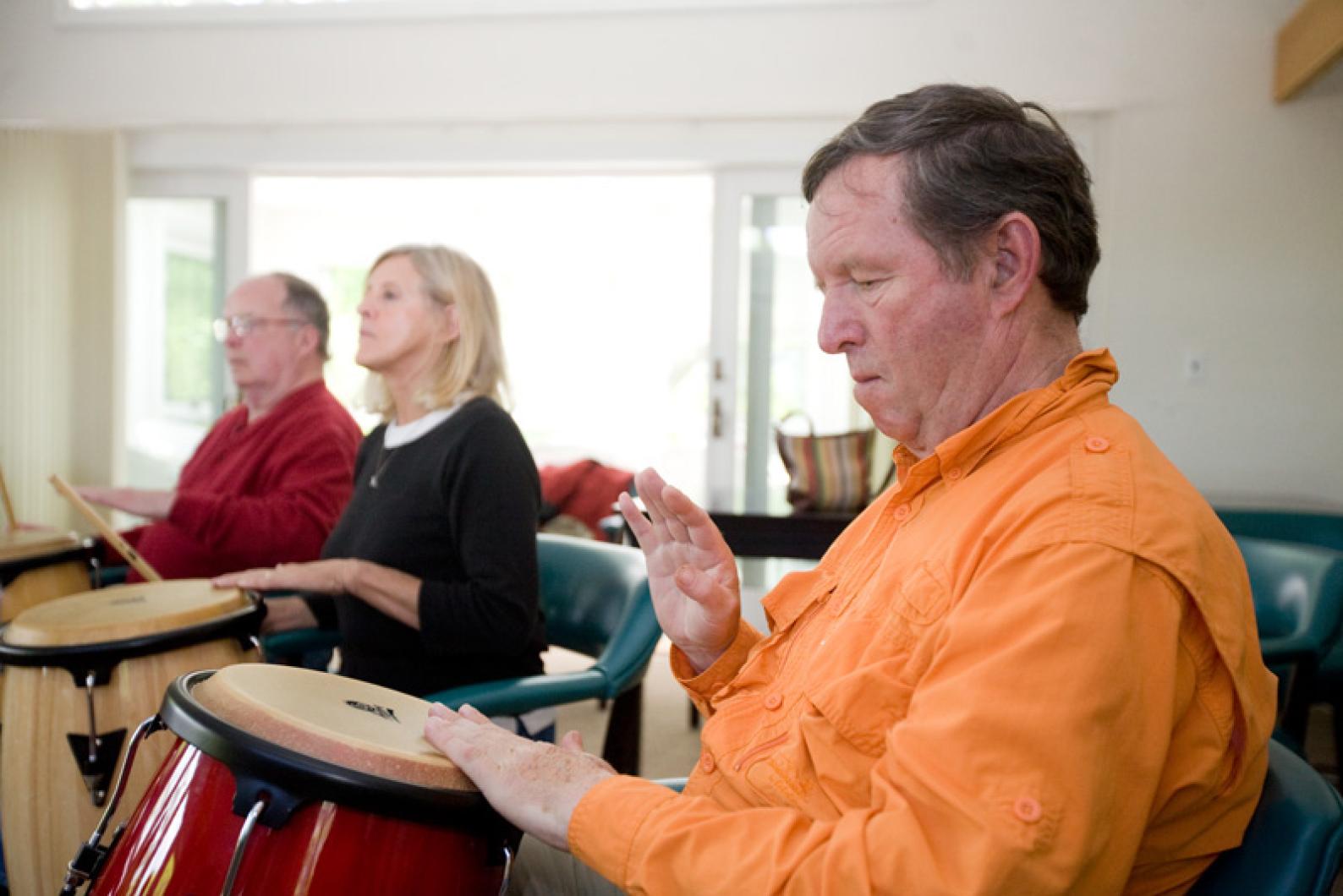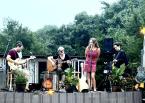Unusual sounds are coming out of the normally sedate Up-Island Senior Center at Howes House this Monday afternoon in May. Shortly after a barefoot man jumps out of a van to unload a set of conga drums, the rhythms from palms and sticks start to reverberate throughout the building.
This is Rick Bausman’s weekly visit with his Drum Workshop program called Rhythms to Routes, designed to help people with movement disorders. The group formed three years ago as research emerged about the benefits of drumming for people with Parkinson’s disease. It expanded as patients with Lyme disease, arthritis and carpal tunnel syndrome also found relief. Now there are many people in the group who just want to learn to drum.
On this Monday, Parkinson’s patients Ken Beebe and Gary Zwicky are in their regular spots. “I’ve been drumming for two, almost three years.” Mr. Zwicky said, “It takes your mind off your motion; Parkinson’s patients tend to freeze.”
Mr. Beebe has been drumming for about a year and finds that drumming helps him walk. “It gets the rhythm going and forces my mind to work quickly,” he said, noting that he gets similar benefits from his daily ritual of fly-fishing. He says the rhythm of drumming is similar to the rhythm of fly-casting. “And they’re both like meditation — you can’t think about anything else.”
Five people come in just for the fun of playing, and a few have their own drums. Mr. Bausman sets them up in a circle and begins to assign parts and name the tones he wants to achieve with different techniques. After demonstrating the difference between a muff (or muffled tone) and a gung (a more open tone) and how they are achieved with hand or stick strokes, he starts them on a Nigerian rhythm called Batakatu and moves on to another called Yanvalou Franc.
“Sometimes there’s too much thinking. You need to let the other side of the brain take over,” Mr. Bausman advises his group. He also tells them to relax their shoulders to make it easier to use the stick.
As the tempo increases, newcomer Evelyn Kreyling hits herself on the head with the stick and collapses in laughter while others encourage her. Mr. Beebe calls out, “You can’t think that fast; you just fall into the groove.” Shirley Craig adds, “You can feel it more when it’s going faster.” Tomar Walman says, “The thing is not to think.” And Ms. Kreyling rejoins the group.
Why Mr. Bausman is barefoot becomes more apparent when he gets down on the floor, tips his drum sideways to play it with his left hand, and bangs a stick on a cowbell he holds with his toes. He calls out to Mr. Beebe not to overdo his stick work. “Don’t worry, if it’s going to interfere with my fly-casting, I won’t do it,” Mr. Beebe said. When they get going too fast Mr. Bausman tries to slow them down by saying, “You can submit your suggestions for tempo.”
The last piece is a three-part rhythm from Ghana called Gahu and everyone is standing. Mr. Bausman demonstrates each part to the different sections and then they’re off, faster and faster. At one point Ms. Kreyling lets out a whoop and holds her sticks in the air but jumps back in for the big finish that leaves everyone smiling. Mr. Bausman asks, “Did everyone remember to breathe?”
When the group files out, it’s evident that there is also a simple social component to ensemble drumming as they make plans to meet again the next week. Howes House social worker Ellen Reynolds, herself a drummer, explained that there was never any specific funding for this program. “We just asked Rick to come and everyone contributes what they can.”
Benefits for Parkinson’s patients are shown in studies nationwide — some combination of the vibrations and the rhythm from drumming can not only reduce tremors but also enables the body to carry the rhythm over, to help the patient initiate movement. The rhythm retrains the brain to access alternate neurological pathways.
But learning a new repetitive skill seems to open pathways in the brain for other challenges. Sandra Kingston took her parents and saw a benefit especially for her mother, who was recovering from chemotherapy treatments and possibly in the early stages of dementia. “Her speech pattern improved, she was able to think better, and she was more cooperative,” Ms. Kingston said, and she found that the results lasted for a couple of days.
After contracting Lyme disease, Ms. Kingston returned on her own and discovered that drumming improved the concentration issues she was having as a result of Lyme. Now she’s a Drum Workshop board member and fund-raiser.
Mr. Bausman founded the nonprofit Drum Workshop in 1987 and has run a variety of programs in all of the Island schools, where ensemble drumming has helped with self-esteem and self-discipline issues. He has designed special programs for developmentally disabled and at-risk children as well as anger management skills for prisoners. These programs are funded in part by the institutions but subsidized by the organization.
As word spread about the programs, other schools and groups contacted him. Mr. Bausman is working with a group at Boston University Medical Center to implement his Parkinson’s program, and he has acted as a facilitator to help integrate his curriculum with school programs around the country.
His most ambitious program, We Drum As One, is a coexistence course he will use with students who travel to Boston this summer under a program sponsored by Artsbridge Institute, a group working to facilitate understanding between Israeli and Palestinian youth.
“I’d like to help a few people understand that they don’t have to blow each other up,” Mr. Bausman said. In the fall he expects to travel to Israel to continue this teaching.
“My board has to slow me down from going in too many directions,” Mr. Bausman said — but the economic downturn is slowing him down too. A number of his financial contributors have had to pull out completely this year.
That will put a hold on his plans to hire an assistant and locate a facility where he can conduct classes and run training programs for teachers and therapists.
He hopes that being selected by Jewish Causes of Choice, a clearinghouse for charitable contributions, will attract new support. The Drum Workshop is one of only 18 nonprofits recommended by the organization.
“With a relatively small amount we can do a huge amount of work,” he said. “And I’ve got a hundred irons in the fire.”







Comments
Comment policy »